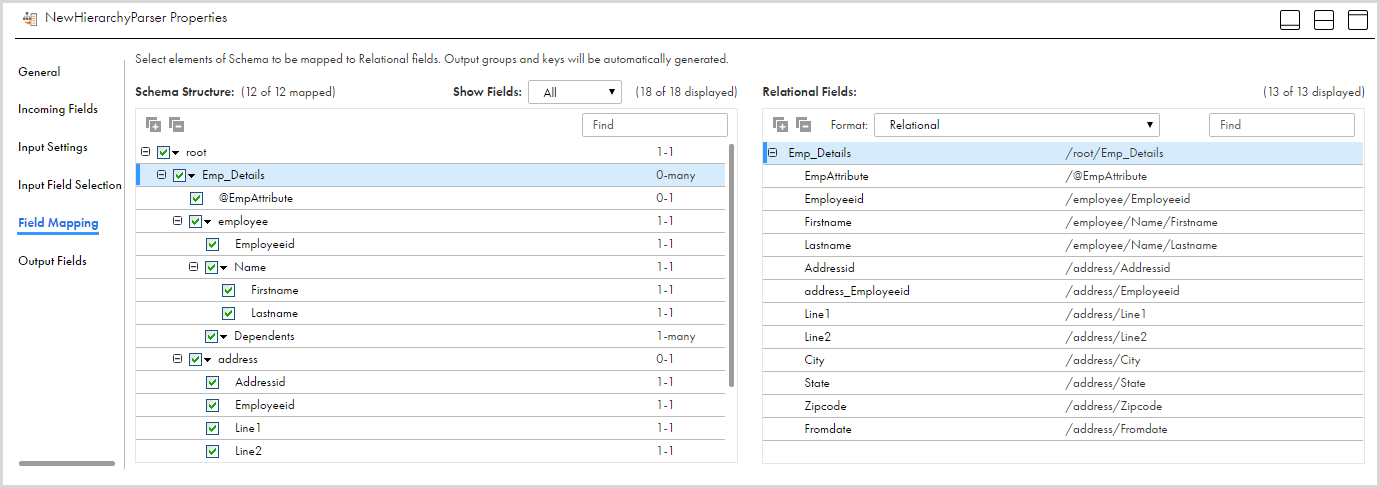Data Integration
- Data Integration
- All Products

<xs:schema xmlns:xs="http://www.w3.org/2001/XMLSchema" xmlns="http://www.itemfield.com" targetNamespace="http://www.itemfield.com" elementFormDefault="qualified"> <xs:element name="root"> <xs:complexType> <xs:sequence> <xs:element name="Emp_Details" minOccurs="0" maxOccurs="unbounded"> <xs:complexType> <xs:sequence> <xs:element name="employee"> <xs:complexType> <xs:sequence> <xs:element name="Employeeid" type="xs:short"/> <xs:element name="Name"> <xs:complexType> <xs:sequence> <xs:element name="Firstname" type="xs:string"/> <xs:element name="Lastname" type="xs:string"/> </xs:sequence> </xs:complexType> </xs:element> <xs:element name="Dependents" minOccurs="1" maxOccurs="unbounded"/> </xs:sequence> </xs:complexType> </xs:element> <xs:element name="address" minOccurs="0"> <xs:complexType> <xs:sequence> <xs:element name="Addressid" type="xs:byte"/> <xs:element name="Employeeid" type="xs:short"/> <xs:element name="Line1" type="xs:string"/> <xs:element name="Line2" type="xs:string"/> <xs:element name="City" type="xs:string"/> <xs:element name="State" type="xs:string"/> <xs:element name="Zipcode" type="xs:int"/> <xs:element name="Fromdate" type="xs:date"/> </xs:sequence> </xs:complexType> </xs:element> </xs:sequence> <xs:attribute name="EmpAttribute" type="xs:string"/> </xs:complexType> </xs:element> </xs:sequence> </xs:complexType> </xs:element> </xs:schema>
<itm:root xmlns:itm="http://www.itemfield.com"> <!--Zero or more repetitions:--> <itm:Emp_Details EmpAttribute="string"> <itm:employee> <itm:Employeeid>1</itm:Employeeid> <itm:Name> <itm:Firstname>Gina</itm:Firstname> <itm:Lastname>Aniston</itm:Lastname> </itm:Name> <!--1 or more repetitions:--> <itm:Dependents>anyType</itm:Dependents> </itm:employee> <!--Optional:--> <itm:address> <itm:Addressid>2</itm:Addressid> <itm:Employeeid>1</itm:Employeeid> <itm:Line1>Long Tech Park</itm:Line1> <itm:Line2>Industrial Zone</itm:Line2> <itm:City>Wichita</itm:City> <itm:State>KA</itm:State> <itm:Zipcode>773301</itm:Zipcode> <itm:Fromdate>2011-09-29</itm:Fromdate> </itm:address> </itm:Emp_Details> </itm:root>



EmpAttribute
| Employeeid
| Firstname
| Lastname
| Addressid
| Employeeid1
| Line1
| Line2
|
|---|---|---|---|---|---|---|---|
string
| 1
| Gina
| Aniston
| 2
| 1
| Long Tech Park
| Industrial Zone
|
City
| State
| Zipcode
| Fromdate
|
|---|---|---|---|
Wichita
| KA
| 773301
| 9/29/2008 12:00:00 AM
|